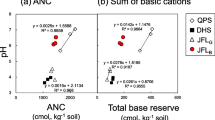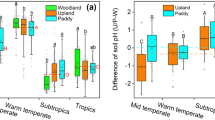Abstract
Aims
Increased nitrification risks accelerating soil acidification under land-use change from tropical forest to cropland or plantation, but acidity might be neutralized by net mineralization of soil organic matter (SOM) that has accumulated under the former fallow vegetation. We aim to analyze key drivers of soil acidification and acid neutralization under different crops and fallow vegetation.
Methods
We compared 30 year changes in soil C stocks, pH, and exchangeable Al under different land-uses (primary dipterocarp forest, Macaranga forest, Imperata grassland, Imperata grassland converted to Acacia plantation, Imperata grassland converted to oil palm plantation) in Indonesia and identified the major drivers of acidification using proton budgets in soil.
Results
Nitrification is major driver of acidification in soil profiles under N-fixing Acacia or fertilized oil palm plantation. Protons generated by product removal and nitrification in oil palm plantation are neutralized partly by fertilizer and mineralization of the native SOM that has formerly accumulated under grassland. The remaining acidity results in accumulation of soil exchangeable Al. The SOM storage under short-term (< 10 yr) grass or long-term (> 10 yr) Macaranga forest increases without intensive acidification, while long-term Acacia plantation maximizes both SOM storage and acidification.
Conclusion
Magnitude of soil acidification is regulated largely by the balance between proton generation by nitrification of fertilized N and biologically-fixed N and proton consumption by net mineralization of the native SOM that has formerly accumulated under grass fallow. SOM accumulation under Imperata grassland or Macaranga forest could mitigate soil acidification in Acacia or oil palm plantation.






Similar content being viewed by others
References
Brahy V, Deckers J, Delvaux B (2000) Estimation of soil weathering stage and acid neutralizing capacity in a toposequence Luvisol-Cambisol on loess under deciduous forest in Belgium. Eur J Soil Sci 51:1–13
Bredemeier M, Matzner E, Ulrich B (1990) Internal and external proton load to forest soils in northern Germany. J Environ Qual 19:469–477
Cleveland CC, Reed SC, Townsend AR (2006) Nutrient regulation of organic matter decomposition in a tropical rain forest. Ecology 87:492–503
Fujii K, Funakawa S, Hayakawa C, Kosaki T (2008) Contribution of different proton sources to pedogenetic soil acidification in forested ecosystems in Japan. Geoderma 144:478–490
Fujii K, Funakawa S, Hayakawa C, Sukartiningsih KT (2009a) Quantification of proton budgets in soils of cropland and adjacent forest in Thailand and Indonesia. Plant Soil 316:241–255
Fujii K, Uemura M, Funakawa S, Hayakawa C, Sukartiningsih KT, Ohta S (2009b) Fluxes of dissolved organic carbon in two tropical forest ecosystems of East Kalimantan, Indonesia. Geoderma 152:127–136
Fujii K, Hartono A, Funakawa S, Uemura M, Sukartiningsih KT (2010) Acidification of tropical forest soils derived from serpentine and sedimentary rocks in East Kalimantan, Indonesia. Geoderma 163:119–126
Fujii K, Funakawa S, Kosaki T (2012) Soil acidification: natural process and human impacts. Pedologist 55:415–425
Fujii K, Hayakawa C, Inagaki Y, Kosaki T (2020a) Effects of land use change on turnover and storage of soil organic matter in a tropical forest. Plant Soil 446:425–439
Fujii K, Kanetani S, Tetsuka K (2020b) Effects of volcanic parent materials on the acid buffering capacity of forest soils on Yakushima Island, Japan Soil Sci Plant Nutr 1–13
Furrer G, Sollins P, Westall JC (1990) The study of soil chemistry through quasi-steady-state models: II. Acidity of soil solution Geochim et Cosmochim Acta 54:2363–2374
Guhardja E, Fatawi M, Sutisna M, Mori T, Ohta S (Eds.) (2012) Rainforest ecosystems of East Kalimantan: El Niño, drought, fire and human impacts (Vol. 140). Springer Science & Business Media
Guo JH, Liu XJ, Zhang Y, Shen JL, Han WX, Zhang WF, Christie P, Goulding KWT, Vitousek PM, Zhang FS (2010) Significant acidification in major Chinese croplands. Science 327:1008–1010
Helyar KR, Porter WM (1989) Soil acidification, its measurement and the processes involved. Soil acidity and plant growth 61102
Islam KR, Weil RR (2000) Land use effects on soil quality in a tropical forest ecosystem of Bangladesh. Agri Ecosys Environ 79:9–16
Kimetu JM, Lehmann J, Ngoze SO, Mugendi DN, Kinyangi JM, Riha S, Verchot L, Recha JW, Pell AN (2008) Reversibility of soil productivity decline with organic matter of differing quality along a degradation gradient. Ecosystems 11:726–739
Kotowska MM, Leuschner C, Triadiati T, Meriem S, Hertel D (2015) Quantifying above-and belowground biomass carbon loss with forest conversion in tropical lowlands of S umatra (Indonesia). Global change biology 21(10):3620–3634
Mualem Y, Dagan G (1978) Hydraulic conductivity of soils: unified approach to the statistical models. Soil Sci Soc Am J 42:392–395
Poss R, Smith CJ, Dunin FX, Angus JF (1995) Rate of soil acidification under wheat in a semi-arid environment. Plant Soil 177:85–100
Qualls RG (2000) Comparison of the behavior of soluble organic and inorganic nutrients in forest soils. For Ecol Manag 138:29–50
Schlesinger WH, Bernhardt ES (2013) Biogeochemistry: an analysis of global change. Academic Press
Slessarev EW, Lin Y, Bingham NL, Johnson JE, Dai Y, Schimel JP, Chadwick OA (2016) Water balance creates a threshold in soil pH at the global scale. Nature 540(7634):567–569
Soil Survey Staff (2014) Keys to Soil Taxonomy, 12th ed. USDA-Natural Resources Conservation Service, Washington, DC
Ugolini FC, Sletten RS (1991) The role of proton donors in pedogenesis as revealed by soil solution studies. Soil Sci 151:59–75
Ulrich B, Sumner ME (Eds.) (2012) Soil acidity. Springer Science & Business Media
Van Breemen N, Mulder J, Driscoll CT (1983) Acidification and alkalization of soils. Plant Soil 75:283–308
Van Breemen N, Driscoll CT, Mulder J (1984) Acidic deposition and internal proton in acidification of soils and waters. Nature 307:599–604
Van Genuchten MT (1980) A closed-form equation for predicting the hydraulic conductivity of unsaturated soils. Soil Sci Soc Am J 44:892–898
Yamakura T, Hagihara A, Sukardjo S, Ogawa H (1986) Aboveground biomass of tropical rain forest stands in Indonesia Borneo. Vegetatio 68:71–82
Acknowledgments
The authors wish to thank the Tropical Rainforest Research Center, Mulawarman University, for allowing us to conduct our experiments. This work was financially supported by a Japan Society for the Promotion of Science (JSPS) grant (No. 26850105, No. 20H03120).
Author information
Authors and Affiliations
Corresponding author
Additional information
Responsible Editor: Wen-Hao Zhang.
Publisher’s note
Springer Nature remains neutral with regard to jurisdictional claims in published maps and institutional affiliations.
Rights and permissions
About this article
Cite this article
Fujii, K., Toma, T. & Sukartiningsih Comparison of soil acidification rates under different land uses in Indonesia. Plant Soil 465, 1–17 (2021). https://doi.org/10.1007/s11104-021-04923-y
Received:
Accepted:
Published:
Issue Date:
DOI: https://doi.org/10.1007/s11104-021-04923-y




